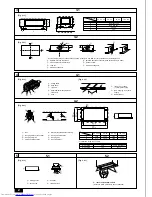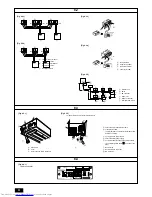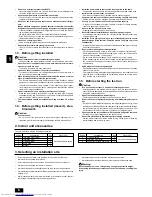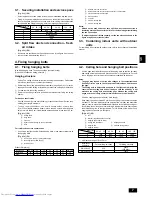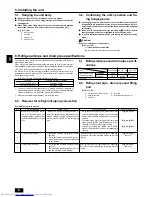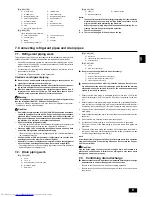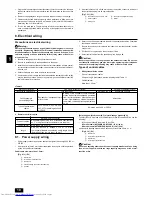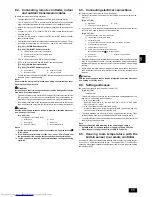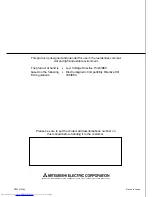
10
GB
D
F
I
NL
E
P
GR
RU
TR
8.1. Power supply wiring
•
Power supply cords of appliances shall not be lighter than design 245 IEC or
227 IEC.
•
A switch with at least 3 mm contact separation in each pole shall be provided
by the Air conditioner installation.
Power cable size: more than 1.5 mm
2
[Fig. 8.1.1] (P.3)
A
Switch 16 A
B
Overcurrent protection 16 A
C
Indoor unit
D
Total operating current be less than 16 A
E
Pull box
8. Electrical wiring
Precautions on electrical wiring
Warning:
Electrical work should be done by qualified electrical engineers in accord-
ance with “Engineering Standards For Electrical Installation” and supplied
installation manuals. Special circuits should also be used. If the power cir-
cuit lacks capacity or has an installation failure, it may cause a risk of elec-
tric shock or fire.
1. Be sure to take power from the special branch circuit.
2. Be sure to install an earth leakage breaker to the power.
3. Install the unit to prevent that any of the control circuit cables (remote control-
ler, transmission cables) is brought in direct contact with the power cable out-
side the unit.
4. Ensure that there is no slack on all wire connections.
5. Some cables (power, remote controller, transmission cables) above the ceiling
may be bitten by mouses. Use as many metal pipes as possible to insert the
cables into them for protection.
1. Plug the drain pump test connector (accessory) into the connector on the same
side as the control box. For more details, see the information on the control box
cover.
2. Remove the polyethylene plug on the same side as the indoor unit piping.
3. Fill water into the feed water pump using a feed water tank. In filling, be sure to
put the end of the pump or tank in a drain pan. (If the insertion is incomplete,
water may flow over the machine.)
4. Turn on the main power. The drain pump is forced to operate without any re-
mote controller operation. Make sure using a transparent hose that drain is
discharged.
5. After confirmation, turn off the main power, remove the connector, and insert
the polyethylene plug into its original position.
[Fig. 7.3.1] (P.3)
A
Insert the pump’s end 2 to 4 cm.
B
Remove the polyethylene plug.
C
About 1000 cc
D
Water
E
Filling port
Building, clinic, hospital or communications
station without noise supposedly generated
from inverter equipment, private power gen-
erator, high-frequency medical equipment,
radio-used communications equipment and
so on
Residence or independent store
without noise
Facility example
(for noise judgment)
All facilities
VCTF, VCTFK, CVV, CVS, VVR,
VVF, VCT or shielding wire CVVS
or CPEVS
Shielding wire CVVS or CPEVS
Types of transmission
cables
System configuration
For a single-refrigerant system
For a multi-refrigerant system
Transmission cable length
Less than 120 m
More than 120 m
Regardless of length
2. Remote controller cables
Network remote controller
Types of cables
Non-shielding wire for up to 10 m; the same specifications
as “1.” Wiring transmission cables for more than 10 m
Cable diameter
More than 0.5 to 0.75 mm
2
Length
Add any portion in excess of 10 m to within
the longest allowable transmission cable length 200 m
(Shielding portion is more than 1.25 mm
2
)
6. Never connect the power cable to leads for the transmission cables. Otherwise
the cables would be broken.
7. Be sure to connect control cables to the indoor unit, remote controller, and the
outdoor unit.
8. Put the unit to the ground on the outdoor unit side.
9. Select control cables from the conditions given in page
10
.
Caution:
Be sure to put the unit to the ground on the outdoor unit side. Do not con-
nect the earth cable to any gas pipe, water pipe, lightening rod, or telephone
earth cable. Incomplete grounding may cause a risk of electric shock.
Types of control cables
1. Wiring transmission cables
•
Types of transmission cables
Design wiring in accordance with the following table <Table 1>.
•
Cable diameter
More than 1.25 mm
2
<Table 1>
[Selecting non-fuse breaker (NF) or earth leakage breaker (NV)]
To select NF or NV instead of a combination of Class B fuse with switch, use the
following:
•
In the case of Class B fuse rated 15 A or 20 A,
NF model name (MITSUBISHI): NF30-CS (15 A) (20 A)
NV model name (MITSUBISHI): NV30-CA (15 A) (20 A)
Use an earth leakage breaker with a sensitivity of less than 30 mA 0.1 s.
[Fig. 8.1.2] (P.3)
E
Switch 16 A
F
Overcurrent protection 16 A
G
Switch 16 A
H
Overcurrent protection 16 A
Caution:
Do not use anything other than the correct capacity breaker and fuse. Using
fuse, wire or copper wire with too large capacity may cause a risk of mal-
function or fire.


